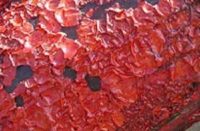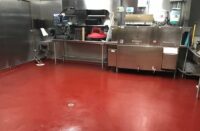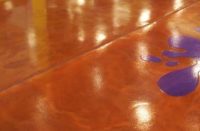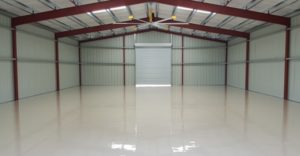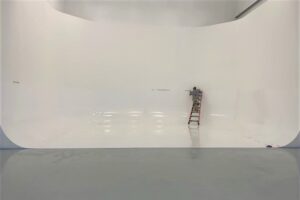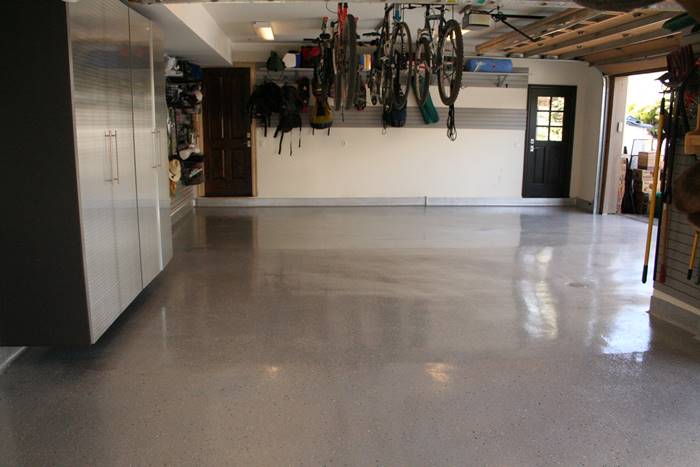
What coating material with a long name allows you to complete projects in less time? Polyaspartic aliphatic polyurea.
Polyaspartic coatings and sealers are based on chemistry developed and patented by Bayer MaterialScience LLC. Ed Squiller, Bayer MaterialScience director of business development, polyisocyanates, aptly defines them. “Polyaspartic esters are high-performance resins used to make two-component light-stable coatings for the construction and corrosion markets. The fully reacted coating cures to a hard, durable finish that offers many outstanding properties.”‘
Bayer recommends many uses for polyaspartics. Two of those will particularly impress decorative concrete contractors. They can use them in clear topcoats for acid-stained concrete and in bases and topcoats for fast-curing garage floor coatings.
Installers commonly apply polyaspartic coatings in two or three coats when used on garage floors. The first penetrates and seals the concrete and serves as a primer for subsequent applications. The second layer is often pigmented and serves as the bed for color chips or other decorative additions. The topcoat protects the surface from wear.
Benefits abound
Rapid cure is one of the material’s key benefits. Depending on the formulation, the primer or seal coat can be tack-free and ready for the second coat in 30 to 45 minutes. The mid-coat or chip coat can be ready to seal in as early as an hour. The topcoat can usually be walked on in three to four hours. And, it will stand up to vehicle traffic in 24 hours.
Polyaspartics deliver several other benefits too. Their UV stability prevents yellowing and material degradation in outdoor applications. They also protect the underlying concrete color from UV degradation.
Polyaspartics deliver high-abrasion resistance, so they wear well and retain their gloss in traffic areas. These coatings also resist stains, acid and chemicals. This makes them a good choice for harsh environments from industrial floors and garages to commercial kitchens and breweries.
Unlike some sealers or other coatings, polyaspartics cure by two components cross-linking, not by temperature or humidity. As a result, they can be applied across a wide range of temperature and weather conditions. They also have low VOCs and very low-odor compared to other coating materials.
Chemistry counts
The performance of a polyaspartic depends largely on the chemistry or blend of the formulation. “You want to keep the chemistry as pure as you can,”‘ says Mason Harms, trainer for manufacturer Advacoat. “The more different things you add, the weaker the chemistry. We’ve tried to keep out everything that might cause delamination'”
You can adjust polyaspartic coating formulations to balance various features. “We’ve worked long and hard on developing formulations to get a high-performance balance of desired wetting, moisture blocking, UV stability, chemical resistance and abrasion resistance,”‘ says Doug Bannister, founder and partner of One Day Floors, which formulates and sells polyaspartic coatings.
Polyaspartics tend to have a high price per gallon compared to other products. To lower that price, some manufacturers may reduce solids content or add plasticizers or other less-expensive ingredients.
One common failure of poorly blended polyaspartics is delamination over time. “As a contractor, you want a good, dependable product,”‘ says Joe Sheehan, owner of Garage Floors 1, based in Minneapolis. “You need to be sure that what’s listed on the label is what’s in the can.”‘ Sheehan is also a partner in One Day Floors.
Rather than look for lower prices, contractors should evaluate the total cost of applying polyaspartics, says Harms. “The cost can be 20 to 30 percent higher per gallon than epoxies, but you can upsell the customer on better performance and quicker turnaround.” The potential for getting a higher price and reducing labor hours means that a polyaspartic-coated floor can net a contractor a 10 percent to 15 percent higher profit.
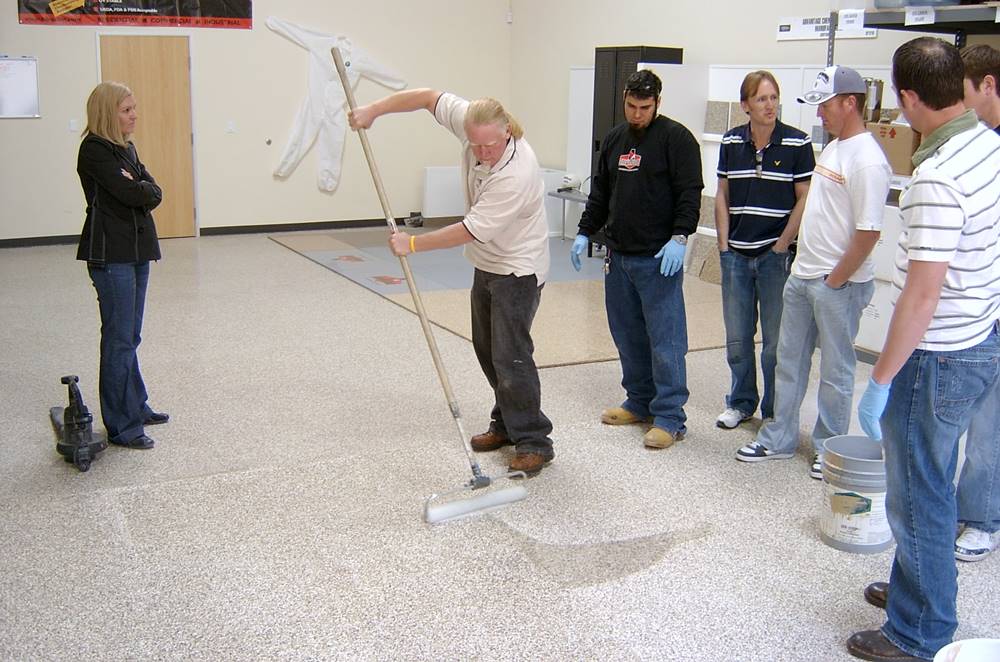
How to apply
Like every good concrete finish, preparation is the most important step. In the case of polyaspartics, the concrete needs to be open and porous.
Manufacturers recommend grinding the surface to a profile between 50 grit and 100 grit. This helps achieve uniform wetting and penetration of the pores. Laitance and contaminants such as oils, fats, old sealers and cure-and-seal bond breakers should be ground off following manufacturers’ directions.
It’s possible to apply a polyaspartic to a stamped surface, but timing is sensitive. The concrete must be fresh enough to have open pores, but sufficiently cured (typically 30 days) to prevent delamination caused by moisture vapor transmission.
When it comes to applying the polyaspartic, the biggest challenge contractors face is leaving behind their previous experience and techniques. “When I train guys I tell them it’s reverse thinking,” says Sheehan. “Whatever you knew about epoxy, go the opposite direction.”
While “opposite” may be an exaggeration, the differences between polyaspartics and traditional epoxies are significant enough to require training and a change of mind-set. Here are some examples:
Do things differently
Profile is extremely important. Polyaspartics perform at thinner applications and aren’t self-leveling like epoxies. Consequently, flaws or obvious repairs in the underlying floors will be reflected.
Polyaspartics are less sensitive to temperature and humidity. This means you can apply them across a broader range of conditions than other coating materials. Also, they aren’t sensitive to alkalinity.
Of course, the factor that makes the biggest difference is cure rate. When the two components are first mixed, the coating is the consistency of water. Within 20 to 30 minutes it will thicken to the point that wetting capability is diminished.
“You really have to move fast to keep maximum wetting,”‘ Sheehan says. “The material is curing and changing even as you’re using it.” He recommends starting with an area of just 500 square feet and mixing and applying one batch at a time after that. With practice and the right roller techniques, he says, a contractor can work up to sealing 1,000 square feet in about 15 minutes.
And, says Sheehan, “Every time you use polyaspartic, plan to throw away the roller.”
Most manufacturers require customers to go through training for approval and certification to apply their products. “This is not a do-it-yourself product,”‘ says Harms. Advacoat requires training before a contractor can buy its Advacoat polyaspartic coatings. Flexmar Coatings and One Day Floors have the same policy.
Decorative history
The first and still most common decorative use for polyaspartics is in tough garage floors with decorative color chips or flakes. This same technique has carried over successfully to industrial and warehouse settings.
When color chips are used in the three-coat process described above, the color comes from the chips, not the coating. Harms recommends adding the chips to a pigmented mid-coat before it becomes tack-free. Then scrape and sweep up the excess chips before applying a clear topcoat.
With quartz or other slip-resistant media substituted for the chips, polyaspartics are attractive for wet environments like commercial kitchens and food preparation operations. The quick turnaround, stain resistance and durability of polyaspartics make them more attractive for retail and restaurant use as well.
Meanwhile, decorative contractors are moving beyond color chips to add excitement to polyaspartic concrete floors. “We use sparkles, iridescent and metallics for the owners who want something more in their floors,”‘ says Bannister. “These are usually commercial spaces — retail and restaurants, bars and wine shops.”‘
Unlike broadcasted chips or flakes, these new decorative materials are usually dry-powder material blended into the polyaspartic before it’s rolled or squeegeed onto the floor.
Coloring is possible
Contractors can color or pigment some polyaspartics. For example, Variegate, new from Flexmar Coatings, incorporates dyes and pigments that simulate the variegated look of an acid stain.
Contractors can test the product in the field. “We’re not positioning this to replace concrete staining,”‘ says Jack Bracco, sole owner of Flexmar Coatings. “We’re just giving decorative concrete contractors a new product to add to their repertoire.”
Polyaspartics have only been in use for decorative concrete for about five years. However, they’re evolving quickly past their use on garage floors. Several things are happening to move them into the mainstream.
One is the weeding out of subperforming products so that consistent, quality formulations from reliable suppliers are widely recognized and available. Another is contractors recognizing that the benefits reaped from polyaspartics are worth making changes in their techniques and habits.
Finally, the market will really grow when contractors and their customers experience polyaspartics’s durability and performance benefits and find new decorative applications for them.
www.advacoat.com
www.bayermaterialscience.com
www.flexmarpolyaspartics.com
www.onedayfloors.net
Questions for Readers
Question
How can I find the mil thickness of the coating? How much top and base coat product should I use?
Answer from Concrete Decor
You measure mil thickness with a mil thickness tester. It’s the size of a credit card and has various sized notches along the edges. You can generally find one of these at a local paint store. The coatings manufacturer will provide information on the required or recommended mil thickness for its product.
Question
Which would you say are the best brands of polyaspartic coatings to use?
Answer from Concrete Decor
Polyaspartics are comparable in quality throughout the industry. As the article you read mentions, raw materials producer “Bayer MaterialScience,” now called Covestro, owns the technology.
An aspect of polyaspartics that does fluctuate is “solids content.” Some contractors prefer high solids content (>100%). Others go with a slightly lower cost product with (>85%) solids content. Keep in mind that abrasion resistance is generally a function of higher solids content.
Another question to consider is who offers a better warranty on their product and who has the best overall reputation. Being the publisher of Concrete Decor for the past 20 years, a couple of names stand out for me: Surecrete and Laticrete.
Keep in mind that polyaspartic coatings are fast-setting products.
